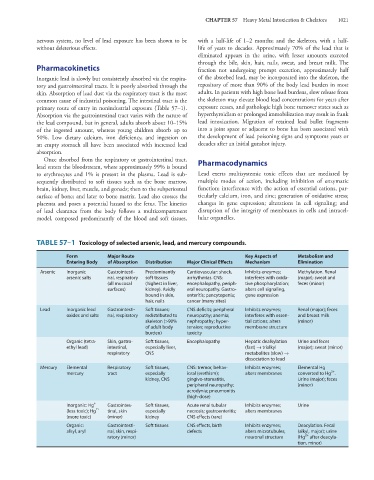Page 1035 - Basic _ Clinical Pharmacology ( PDFDrive )
P. 1035
CHAPTER 57 Heavy Metal Intoxication & Chelators 1021
nervous system, no level of lead exposure has been shown to be with a half-life of 1–2 months; and the skeleton, with a half-
without deleterious effects. life of years to decades. Approximately 70% of the lead that is
eliminated appears in the urine, with lesser amounts excreted
through the bile, skin, hair, nails, sweat, and breast milk. The
Pharmacokinetics fraction not undergoing prompt excretion, approximately half
Inorganic lead is slowly but consistently absorbed via the respira- of the absorbed lead, may be incorporated into the skeleton, the
tory and gastrointestinal tracts. It is poorly absorbed through the repository of more than 90% of the body lead burden in most
skin. Absorption of lead dust via the respiratory tract is the most adults. In patients with high bone lead burdens, slow release from
common cause of industrial poisoning. The intestinal tract is the the skeleton may elevate blood lead concentrations for years after
primary route of entry in nonindustrial exposure (Table 57–1). exposure ceases, and pathologic high bone turnover states such as
Absorption via the gastrointestinal tract varies with the nature of hyperthyroidism or prolonged immobilization may result in frank
the lead compound, but in general, adults absorb about 10–15% lead intoxication. Migration of retained lead bullet fragments
of the ingested amount, whereas young children absorb up to into a joint space or adjacent to bone has been associated with
50%. Low dietary calcium, iron deficiency, and ingestion on the development of lead poisoning signs and symptoms years or
an empty stomach all have been associated with increased lead decades after an initial gunshot injury.
absorption.
Once absorbed from the respiratory or gastrointestinal tract, Pharmacodynamics
lead enters the bloodstream, where approximately 99% is bound
to erythrocytes and 1% is present in the plasma. Lead is sub- Lead exerts multisystemic toxic effects that are mediated by
sequently distributed to soft tissues such as the bone marrow, multiple modes of action, including inhibition of enzymatic
brain, kidney, liver, muscle, and gonads; then to the subperiosteal function; interference with the action of essential cations, par-
surface of bone; and later to bone matrix. Lead also crosses the ticularly calcium, iron, and zinc; generation of oxidative stress;
placenta and poses a potential hazard to the fetus. The kinetics changes in gene expression; alterations in cell signaling; and
of lead clearance from the body follows a multicompartment disruption of the integrity of membranes in cells and intracel-
model, composed predominantly of the blood and soft tissues, lular organelles.
TABLE 57–1 Toxicology of selected arsenic, lead, and mercury compounds.
Form Major Route Key Aspects of Metabolism and
Entering Body of Absorption Distribution Major Clinical Effects Mechanism Elimination
Arsenic Inorganic Gastrointesti- Predominantly Cardiovascular: shock, Inhibits enzymes; Methylation. Renal
arsenic salts nal, respiratory soft tissues arrhythmias. CNS: interferes with oxida- (major); sweat and
(all mucosal (highest in liver, encephalopathy, periph- tive phosphorylation; feces (minor)
surfaces) kidney). Avidly eral neuropathy. Gastro- alters cell signaling,
bound in skin, enteritis; pancytopenia; gene expression
hair, nails cancer (many sites)
Lead Inorganic lead Gastrointesti- Soft tissues; CNS deficits; peripheral Inhibits enzymes; Renal (major); feces
oxides and salts nal, respiratory redistributed to neuropathy; anemia; interferes with essen- and breast milk
skeleton (>90% nephropathy; hyper- tial cations; alters (minor)
of adult body tension; reproductive membrane structure
burden) toxicity
Organic (tetra- Skin, gastro- Soft tissues, Encephalopathy Hepatic dealkylation Urine and feces
ethyl lead) intestinal, especially liver, (fast) → trialkyl (major); sweat (minor)
respiratory CNS metabolites (slow) →
dissociation to lead
Mercury Elemental Respiratory Soft tissues, CNS: tremor, behav- Inhibits enzymes; Elemental Hg
2+
mercury tract especially ioral (erethism); alters membranes converted to Hg .
kidney, CNS gingivo-stomatitis, Urine (major); feces
peripheral neuropathy; (minor)
acrodynia; pneumonitis
(high-dose)
+
Inorganic: Hg Gastrointes- Soft tissues, Acute renal tubular Inhibits enzymes; Urine
2+
(less toxic); Hg tinal, skin especially necrosis; gastroenteritis; alters membranes
(more toxic) (minor) kidney CNS effects (rare)
Organic: Gastrointesti- Soft tissues CNS effects, birth Inhibits enzymes; Deacylation. Fecal
alkyl, aryl nal, skin, respi- defects alters microtubules, (alkyl, major); urine
2+
ratory (minor) neuronal structure (Hg after deacyla-
tion, minor)

